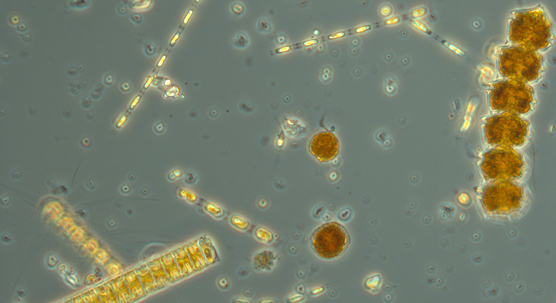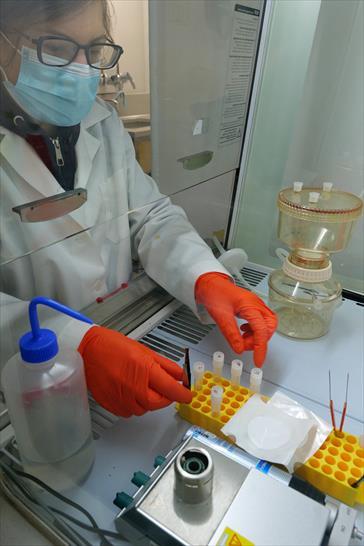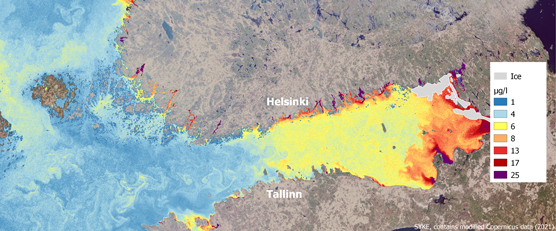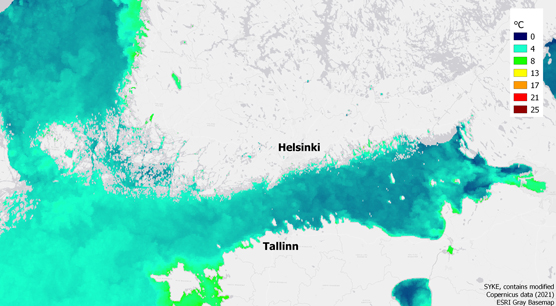Press release 2021-05-18 at 8:00
The annual spring monitoring cruise of R/V Aranda took place in late April. During the cruise the phytoplankton spring bloom was already at its peak in the Gulf of Finland. Spring is the time with the densest phytoplankton blooms in the Baltic Sea, but the phenomena is mostly unnoticed.

Phytoplankton. © Photo: Sirpa Lehtinen
The Finnish Environment Institute SYKE performed annual spring monitoring cruise with R/V Aranda from 20 to 30 April. The cruise covered the Northern Baltic Proper, Gulf of Finland, Åland Sea, Archipelago Sea and Bothnian Sea. During the cruise phytoplankton biomass, nutrients, temperature, oxygen, salinity and pH in the water are measured to study the state of the Baltic Sea.
“With these measurements we can understand the long-term changes in the Baltic Sea caused by eutrophication and climate change. For example, warming is causing noticeable changes in the environment, with less ice during the winter and surface water warming up earlier in the spring. What effect this has on the phytoplankton spring blooms is still uncertain, but there is clear indication that the blooms start earlier and the algal community change,” Senior Research Scientist and cruise leader Kristian Spilling says.
In late April the spring bloom in the Gulf of Finland was quite heterogeneously distributed. The highest concentration of phytoplankton biomass in the water was found off Helsinki, with less biomass in eastern part of the Gulf of Finland and lowest at the westernmost sampling points off Hanko.
“This big difference in phytoplankton biomass within a relatively small area is driven by hydrodynamics, that is water movement and mixing,” Kristian Spilling explains.
In the Baltic Proper the peak of the spring bloom was also close. In the Åland Sea and the Bothnian Sea there was still relatively much nutrients in the surface water and the spring bloom was in the initiation phase. Typically, the peak of the spring bloom is expected around mid-May in the Åland Sea and the Bothnian Sea.
Spring is the time with the densest phytoplankton blooms
Spring is the time with the densest phytoplankton blooms throughout the year. Phytoplankton or algal bloom is a term used for periods when the biomass of pelagic primary producers is extremely high. After the winter the concentrations of nutrients are high in the water and as the light increases the annual phytoplankton spring bloom begins. Though the phytoplankton biomass per unit area may be several times higher in the spring than during summer when easily visible cyanobacterial surface blooms occur, the spring bloom is relatively unknown to the public and often goes unnoticed.
“There are several reasons for this. Firstly, spring bloom is dominated by diatoms and dinoflagellates, which do not form easily visible and unpleasant surface accumulations like cyanobacteria do during summer. Secondly, spring bloom does not cause health risks like cyanobacterial blooms do. Thirdly, the water is still very cold in the springtime and people are not yet spending much time at the sea and along the coastline, so they do not pay so much attention to brownish color of the water. However, fishermen may notice slime in fishing nets during spring bloom,” says Senior Research Scientist Sirpa Lehtinen. She is coordinating the national marine phytoplankton monitoring in Finland.
When the spring bloom species have consumed almost all the nutrients, most of them sink to the sea floor where too high amount of biomass can become an environmental problem. As bacteria decomposing biomass consume oxygen, the bottom water can turn anoxic. This has several negative environmental effects such as release of phosphate, which further aggravates the eutrophication.
Deep water still warmer than usual
During Aranda´s winter cruise earlier this year record high temperatures were measured in some Baltic Sea areas. At the time of the spring cruise the surface temperature was average for the time of year, but the deep water was warm. In the Gulf of Finland, the temperature of deep water was up to 6°C. This temperature is not record high for the area, but among the 10% highest recorded. The temperature was also high in the deep water in the Northern Baltic Proper reaching almost 7°C in some stations. However, in the Åland Sea, where there was record high temperature in the deep water in last January, the temperature was in late April relatively normal (3.6°C at 286 m). The change of temperature in the deep water in Åland Sea is likely due to water movement as there was also more oxygen in the deep water in April (April: 7.3 mg O2 per liter; January: 5.3 mg O2 per liter).

Researcher Jacqueline Jerney preparing genetic samples for phytoplankton monitoring in the laboratory of R/V Aranda. © Photo: Ilkka Lastumäki / SYKE
New DNA-based monitoring methods put to test
Routinely the phytoplankton samples collected during the spring cruise are analyzed in the laboratory according to the internationally standardized microcopy method. This time the researchers ventured into new fields, as they also took genetic samples for phytoplankton.
“This is the first time we will test DNA metabarcoding method in the Finnish marine phytoplankton monitoring. It will be very valuable to know which kind of additional information on biodiversity of pelagic primary producers we will be able to gain with DNA metabarcoding, even though we are aware that there are still many shortcomings in the phytoplankton genetic reference data available for the northern Baltic Sea,” Senior Research Scientist Sirpa Lehtinen says.
Tests with the DNA metabarcoding of eukaryotic phytoplankton are funded by the Finnish Ministry of the Environment. In the year 2021, also bacterial community will be sampled for genetic analyses as a part of the SYKE’s internal eDNA project.
Satellite observations serve marine monitoring
In addition to the monitoring work done onboard the R/V Aranda, the Finnish Environment Institute produces information on the Baltic Sea based on satellite observations. This information is available as open access on the websites TARKKA interface (Link to the TARKKA interface) and MarineFinland.fi (Link to the website MarineFinland.fi).The TARKKA interface shows the daily satellite observations on water quality and surface temperature during cloud-free periods. The website MarineFinland.fi provides insight to different online measurements as time series.

Just before the start of Aranda´s spring cruise, on the 18th of April 2021, the Gulf of Finland and the Gulf of Bothnia were almost cloud-free. This gave a complete view of the phytoplankton spring bloom and coastal springtime processes occurring simultaneously. There was still some ice left at the easternmost part of the Gulf of Finland. The image is composed of two observations from Eu’s Copernicus programme Sentinel-3 satellite´s OLCI instruments and show the Chlorophyll a (Chl a) concentration in micro gram per liter. Highest Chl a values were observed in the eastern Gulf of Finland and in general, the Gulf of Finland has the highest concentration of algae biomass during spring bloom in Finnish waters. The springtime satellite observations of Chl a might not be visually as engaging as the summertime observations of cyanobacteria, but both provide important information on the spatial distribution, peak, timing and length of the bloom. Together with the information on dominant phytoplankton species these indicators provide valuable insight to the annual phytoplankton cycle.

On the 18th of April the surface temperature at the Baltic Sea was typical for the time of year. The image was captured by EU’s Copernicus programme Sentinel-3 satellite´s SLSTR instrument. Although the summerly cyanobacterial blooms are the best sellers in TARKKA, also the observations on phytoplankton spring bloom, water temperature, ice and springtime melting period raise interest among authorities and the general public.
More information
- Senior Research Scientist and cruise leader Kristian Spilling, Finnish Environment Institute SYKE, firstname.lastname@syke.fi, Tel. +358 295 251 656
- Senior Research Scientist Sirpa Lehtinen, Finnish Environment Institute SYKE, firstname.lastname@syke.fi, Tel. +358 295 251 353
- Senior Researcher Jenni Attila (Remote sensing), Finnish Environment Institute SYKE, firstname.lastname@syke.fi, Tel. +358 295 251 078
- Communications Specialist Eija Järvinen, Finnish Environment Institute SYKE, firstname.lastname@syke.fi, Tel. +358 295 251 242
Pictures for media use (full size files)